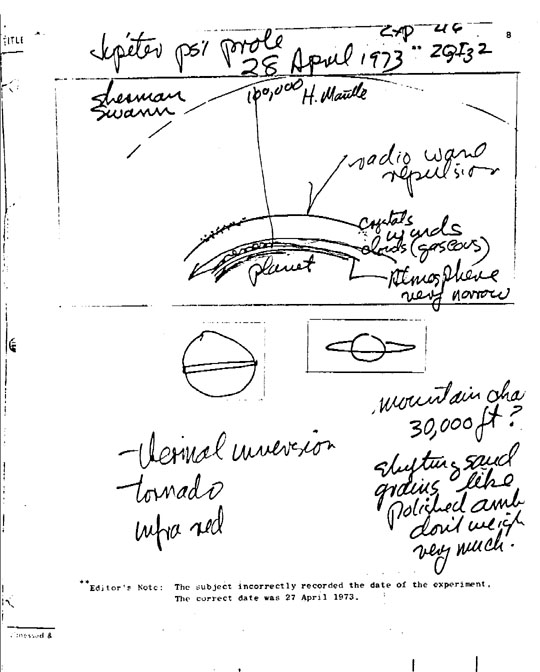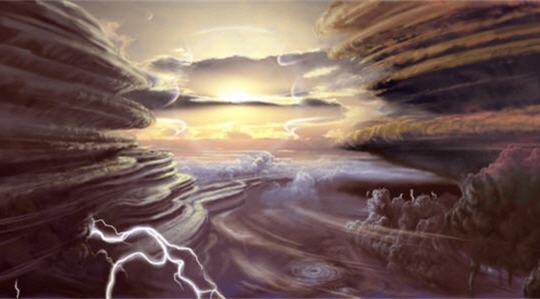Remote Viewing Jupiter before NASA’s Voyager 1

NASA says: Jupiter’s faint rings were not discovered until 1979 when NASA’s Voyager 1 spacecraft flew close to Jupiter. We now know all four giant planets of our solar system have rings.
But this is not true, the ‘Ingo Swann 1973 Remote Viewing probe’ of the planet Jupiter was there first. “The Jupiter Probe was one of a number of early experiments designed to try to discover the dimensions and extent of human remote sensing faculties”. http:www.thelivingmoon.com/44cosmic_wisdom/01documents/Ingo_Swann_Remote_Viewing_Jupiter.htm
Remote viewing session log (April 27, 1973)
Experiment 46
No big sharp noises for the next 1/2 hour please.
6:03:25 (3 seconds fast) There’s a planet with stripes.
6:04:13 I hope it’s Jupiter. I think that it must have an extremely large hydrogen mantle. If a space probe made contact with that, it would be maybe 80,000 – 120,000 miles out from the planet surface.
6:06 So I’m approaching it on the tangent where I can see it’s a half moon, in other words half lit half dark. If I move around to the lit side it’s distinctly yellow toward the right. (Hal – Which direction you had to move?)

6:06:20 Very high in the atmosphere there are crystals, they glitter, maybe the stripes are like bands of crystals, maybe like rings of Saturn, though not far out like that, very close within the atmosphere. [“Note”: see sketch of ring in the raw data drawing ahead.] (Unintelligible sentence.) I bet you they’ll reflect radio probes. Is that possible if you had a cloud of crystals that were assaulted by different radio waves? (Hal – That’s right.)
6:08:00 Now I’ll go down through. It feels really good there (laugh). I said that before, didn’t I? Inside those cloud layers, those crystal layers, they look beautiful from the outside, from the inside they look like rolling gas clouds – eerie yellow light, rainbows.
6:10:20 I get the impression, thought I don’t see, that it’s liquid. 6:10:55 Then I came through the cloud cover, the surface it looks like sand dunes. They’re made of very large grade crystals so they slide. Tremendous winds sort of like maybe the prevailing winds of earth, but very close to the surface of Jupiter. From that view the horizon looks orangish or rose-colored but overhead it’s kind of greenish-yellow.
6:12:35 If I look to the right there is an enormous mountain range.
6:13:18 If I’m giving a description of where I’ve gone and am, it would be approximately where Alaska is if the sun were directly overhead which it is. The sun looks like it has a green corona, seems smaller to me. (Hal – What color is the sun?) White.
 6:14:45 I feel that there’s liquid somewhere. Those mountains (of gas?) are very huge but they still don’t poke up through the crystal cloud cover. You know I had a dream once something like this where the cloud cover was a great arc, sweeps over the entire heaven. Those grains which make that sand orange are quite large. They have a polished surface and they look something like amber or like obsidian but they’re yellowish and not as heavy. The wind blows them, they slide along.
6:14:45 I feel that there’s liquid somewhere. Those mountains (of gas?) are very huge but they still don’t poke up through the crystal cloud cover. You know I had a dream once something like this where the cloud cover was a great arc, sweeps over the entire heaven. Those grains which make that sand orange are quite large. They have a polished surface and they look something like amber or like obsidian but they’re yellowish and not as heavy. The wind blows them, they slide along.
6:16:37 If I turn, the whole thing seems enormously flat. I mean if I get the feeling that if a man stood on those sands I think he would sink into them (laugh) (gas again?); maybe that’s where that liquid feeling comes from.
6:18:10 I see something that looks like a tornado. Is there a thermal inversion here? I bet there is. I bet you that the surface of Jupiter will give a very high infrared count (?), reading (?) (Hal – reading) (inaudible sentence). The heat is held down.
6:19:55 I seem to be stuck, not moving. I’ll move more towards the equator. I get the impression that that must be a band of crystals similar to the outer ones, kind of bluish. They seem to be sort of in orbit, permanent orbit down through another layer farther down which are like our clouds but moving fast. There’s another area: liquid like water. Looks like it’s got icebergs in it but they’re not icebergs.

6:22:20 Tremendous wind. It’s colder here, maybe it’s because there’s not a thermal inversion there.
6:23:25 I’m back. OK. (Hal – very interesting.)
The atmosphere of Jupiter is very thick. I mean … (Ingo draws) … Explanation of drawing: This is what appears to be a hydrogen mantle about 100,000 miles off the surface. Those here are bands of crystals, kind of elements. They’re pretty close to the surface. And beneath those are layers of clouds or what seem to be prevailing winds. Beneath that is the surface which I saw was, well, it looked like shifting sands made out of some sort of slippery granulated stuff. And off in the distance, I guess, to the East was a very high mountain chain 30,000 feet or so, quite large mountains. I feel these crystals will probably bounce radio waves. They’re that type.
Generally, that’s all.
Read it all here
Looking to Wiki for information on the event, I got a biased and sceptical viewpoint that is typically supportive of the skeptic’s creedo. I found that Wiki had omitted the smoking gun, the picture (above) drawn by Swann during the RV session, as skeptics are want to do, and included incomplete and therefore weak evidence – again that’s how the skeptics work.
I checked the Skeptics Dictionary for this one to make sure that the Wiki editors were toeing the party line. Their philosophy regarding remote viewing and Ingo Swann is that anyone achieving something that the skeptics have declared impossible is down to cheating. (no change there) It seems an appeal to cheating is the last resort of a scoundrel.
See Talk Wiki: https://en.wikipedia.org/wiki/Talk:Ingo_Swann for complaints about bias.

GALILEO PROBE SUGGESTS PLANETARY SCIENCE REAPPRAISAL
Galileo launch on October 18, 1989.
Preliminary analysis of early data returned by NASA’s historic Galileo probe mission into Jupiter’s atmosphere has provided a series of startling discoveries for project scientists.
Information on the extent of water and clouds and on the chemical composition of the Jovian atmosphere is particularly revealing. Probe instruments found the entry region of Jupiter to be drier than anticipated, and they did not detect the three-tiered cloud structure that most researchers had postulated. The amount of helium measured was about one-half of what was expected. http://astro.hopkinsschools.org/course_documents/solar_system/outergasplanets/jupiter/atmosphere/atmosphere.htm
The authors experience
During my own out-of-body excursion to Jupiter I found myself below the cloud deck and my attention was fixed upon a huge bubble of water floating on what looked like a denser gas. It was truly huge, rolling, an ocean, a water world in its own right. This may explain NASA’s ‘lack of water’ on a planet constantly bombarded by icy comets – something like that rolling around Jupiter soaking-up all the water in the atmosphere. The “gas giant” Jupiter is more complex and amazing than anyone ever dreamed.
Don’t forget NASA, I saw the water first!
For water abundance in Jupiter’s atmosphere
